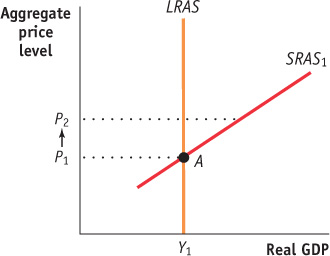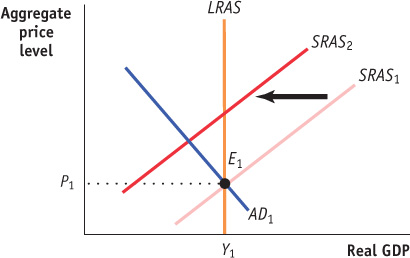12.7 PROBLEMS
A fall in the value of the Canadian dollar against other currencies makes Canadian final goods and services cheaper to foreigners even though the Canadian aggregate price level stays the same. As a result, foreigners demand more Canadian aggregate output. Your study partner says that this represents a movement down the aggregate demand curve because foreigners are demanding more in response to a lower price. You, however, insist that this represents a rightward shift of the aggregate demand curve. Who is right? Explain.
Your study partner is confused by the upward-
sloping short- run aggregate supply curve and the vertical long- run aggregate supply curve. How would you explain the difference?
Suppose that in Wageland all workers sign annual wage contracts each year on January 1. No matter what happens to prices of final goods and services during the year, all workers earn the wage specified in their annual contract. This year, prices of final goods and services fall unexpectedly after the contracts are signed. Answer the following questions using a diagram and assume that the economy starts at potential output.
In the short run, how will the quantity of aggregate output supplied respond to the fall in prices?
What will happen when firms and workers renegotiate their wages?
In each of the following cases, in the short run, determine whether the events cause a shift of a curve or a movement along a curve. Determine which curve is involved and the direction of the change.
As a result of an increase in the value of the Canadian dollar in relation to other currencies, Canadian producers now pay less in dollar terms for foreign steel, a major commodity used in production.
An increase in the quantity of money by the Bank of Canada increases the quantity of money that people wish to lend, lowering interest rates.
Greater union activity leads to higher nominal wages.
A fall in the aggregate price level increases the purchasing power of households’ and firms’ money holdings. As a result, they borrow less and lend more.
The economy is at point A in the accompanying diagram. Suppose that the aggregate price level rises from P1 to P2. How will aggregate supply adjust in the short run and in the long run to the increase in the aggregate price level? Illustrate with a diagram.

Suppose that all households hold all their wealth in assets that automatically rise in value when the aggregate price level rises (an example of this is what is called an “inflation-
indexed bond”—a bond whose interest rate, among other things, changes one- for- one with the inflation rate). What happens to the wealth effect of a change in the aggregate price level as a result of this allocation of assets? What happens to the slope of the aggregate demand curve? Will it still slope downward? Explain.
Suppose that the economy is currently at potential output. Also suppose that you are an economic policy-
maker and that a college economics student asks you to rank, if possible, your most preferred to least preferred type of shock: positive demand shock, negative demand shock, positive supply shock, negative supply shock. How would you rank them and why?
Explain whether the following government policies affect the aggregate demand curve or the short-
run aggregate supply curve and how. The government reduces the minimum nominal wage.
The government increases the size of payments for the child care benefit, government transfers to families with dependent children.
To reduce the budget deficit, the government announces that households will pay much higher taxes beginning next year.
The government reduces military spending.
In Wageland, all workers sign an annual wage contract each year on January 1. In late January, a new computer operating system is introduced that increases labour productivity dramatically. Explain how Wageland will move from one short-
run macroeconomic equilibrium to another. Illustrate with a diagram.
The Conference Board of Canada publishes the Index of Consumer Confidence every month based on a survey of 2000 Canadian households. Many economists use it to track the state of the economy. The latest release showed that the Index of Consumer Confidence increased to 82.2 (2002 = 100) in September 2012, up by 6.7 points from the previous month.
As an economist, do you consider this news encouraging for economic growth?
Explain your answer to part (a) with the help of the AD-
AS model. Draw a typical diagram showing two equilibrium points (E1) and (E2). Label the vertical axis “Aggregate price level” and the horizontal axis “Real GDP.” Assume that all other major macroeconomic factors remain unchanged.How should the federal government respond to this news? What policy measures can it use help neutralize the effect of rising consumer confidence?
The Canadian economy suffered two major shocks in 2008, leading to the severe recession of 2008-2009. One shock was related to oil prices; the other was the slump in both consumer and business confidence. This question analyzes the effect of these two shocks on GDP using the AD-
AS model.Draw typical aggregate demand and short-
run aggregate supply curves. Label the horizontal axis “Real GDP” and the vertical axis “Aggregate price level.” Label the equilibrium point E1, the equilibrium quantity Y1, and equilibrium price P1. Would an increase in oil prices cause a demand shock or a supply shock? Redraw the diagram from part (a) to illustrate the effect of this shock by shifting the appropriate curve.
The New Housing Price Index, published by Statistics Canada, calculates that Canada’s home prices fell by an average of 3% in the 12 months between April 2008 and April 2009. Business fixed capital formation fell by 19% during the same period. Would the fall in home prices and business fixed capital formation cause a supply shock or demand shock? Redraw the diagram from part (b) to illustrate the effect of this shock by shifting the appropriate curve. Label the new equilibrium point E3, the equilibrium quantity Y3, and equilibrium price P3.
Compare the equilibrium points E1 and E3 in your diagram for part (c). What was the (net) effect of the two shocks on real GDP and the aggregate price level (increase, decrease, or indeterminate)?
Using aggregate demand, short-
run aggregate supply, and long- run aggregate supply curves, explain the process by which each of the following economic events will move the economy from one long- run macroeconomic equilibrium to another. Illustrate with diagrams. In each case, what are the short- run and long- run effects on the aggregate price level and aggregate output? There is a decrease in households’ wealth due to a decline in the stock market.
The government lowers taxes, leaving households with more disposable income, with no corresponding reduction in government purchases.
Using aggregate demand, short-
run aggregate supply, and long- run aggregate supply curves, explain the process by which each of the following government policies will move the economy from one long- run macroeconomic equilibrium to another. Illustrate with diagrams. In each case, what are the short- run and long- run effects on the aggregate price level and aggregate output? There is an increase in taxes on households.
There is an increase in the quantity of money.
There is an increase in government spending.
The economy is in short-
run macroeconomic equilibrium at point E1 in the accompanying diagram. Based on the diagram, answer the following questions. 
Is the economy facing an inflationary or a recessionary gap?
What policies can the government implement that might bring the economy back to long-
run macroeconomic equilibrium? Illustrate with a diagram. If the government did not intervene to close this gap, would the economy return to long-
run macroeconomic equilibrium? Explain and illustrate with a diagram. What are the advantages and disadvantages of the government implementing policies to close the gap?
In the accompanying diagram, the economy is in long-
run macroeconomic equilibrium at point E1 when an oil shock shifts the short- run aggregate supply curve to SRAS2. Based on the diagram, answer the following questions. 
How do the aggregate price level and aggregate output change in the short run as a result of the oil shock? What is this phenomenon known as?
What fiscal or monetary policies can the government use to address the effects of the supply shock? Use a diagram that shows the effect of policies chosen to address the change in real GDP. Use another diagram to show the effect of policies chosen to address the change in the aggregate price level.
Why do supply shocks present a dilemma for government policy-
makers?
The late 1990s in Canada was characterized by substantial economic growth with low inflation; that is, real GDP increased with little, if any, increase in the aggregate price level. Explain this experience using aggregate demand and aggregate supply curves. Illustrate with a diagram.